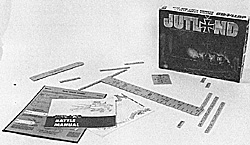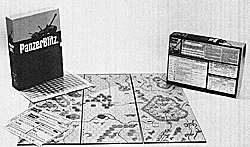Two Exceptions to the Importance of Psychological Factors in Battle
"The all-importance of the psychological factor
is applicable only to land warfare. On the sea or in the
air it is less important since the men are held together
by their equipment. You cannot abandon your ship or
your aircraft. As a result the equipment factor has as a
rule been all important in naval and air strategy -- such
questions as speed, maneuverability, range, protection,
weight of salvo, have generally been decisive.
Moreover, whereas on land the object is to disorganize
the enemy, on the sea or in the air it is to destroy him
physically."
 Thus Jutland, like most naval battle games, requires the kind of careful research the simulators
excel in. The game is a good simulation precisely because this is one kind of war in which "counting rifles" dominates.
Thus Jutland, like most naval battle games, requires the kind of careful research the simulators
excel in. The game is a good simulation precisely because this is one kind of war in which "counting rifles" dominates.
Panzerblitz shares many of the same features. Like miniature wargaming to which it is very similar, Panzerblitz has no "operations"; battle is everything. The forces, terrain, and objectives are set by the rules, and the player is not allowed to decide whether the battle should have been fought in the first place. Also, the scale is small; Panzerblitz is a game of armor minor tactics.
Mocksey, in the Ballantine book Panzer Division points out that in modern war infantry must be dispersed and thus separated from officers and comrades. S.L.A. Marshal has often noted the problem of infantrymen who will fight only when under the eyes of their officers. The temptation to crouch in a foxhole waiting for death when you are alone and afraid in a world of smoking hell has often been described.
This problem was solved in the Roman era by making the troops more afraid of their officers than of the enemy. Marlborough kept all but the picked men in massed ranks. Modern infantrymen, though, fi8ht nearly alone, and are thus disorganized.
This almost never happened with armored forces. Mocksey points out that "even when they failed the tank crews almost invariably kept on fighting a trait belonging not only to tank crews, but with the same dedication to the crews of armored infantry carriers and armored artillery or assault guns. Thus it is likely that, by being penned inside a steel protective box, fighting men found a new unity in fear even though they fought in small parties.
 "In an armored vehicle it is far less easy for a frightened man to give way to his fears. He knows that somebody in the crew is determined to carry on...so the driver lets in the clutch and carries them all forward, while the remainder are compelled, whether they like it or not, to fire on the enemy with their powerful weapons. Thus an armored vehicle is a mobile cage enclosing courage."
"In an armored vehicle it is far less easy for a frightened man to give way to his fears. He knows that somebody in the crew is determined to carry on...so the driver lets in the clutch and carries them all forward, while the remainder are compelled, whether they like it or not, to fire on the enemy with their powerful weapons. Thus an armored vehicle is a mobile cage enclosing courage."
Thus we see why the narrow "counting rifles" simulation method works to produce two very good games like Jutland and Panzerblitz, yet fails so dismally with others. The real world situations these games simulate are dominated, not by morale, but by materiel. This is not true of land warfare much above the level of minor tactics, nor even at that level except in armor.
More Simulation and Psychology
-
Introduction
What Are We Trying to Simulate?
Strategy
What Can We Simulate?
A History of Operations
Panzerblitz and Jutland
Back to Conflict Number 3 Table of Contents
Back to Conflict List of Issues
Back to MagWeb Master Magazine List
© Copyright 1998 by Dana Lombardy
This article appears in MagWeb (Magazine Web) on the Internet World Wide Web.
Other military history articles and gaming articles are available at http://www.magweb.com
E-mail MagWeb if you find broken links, missing graphics, or other problems.